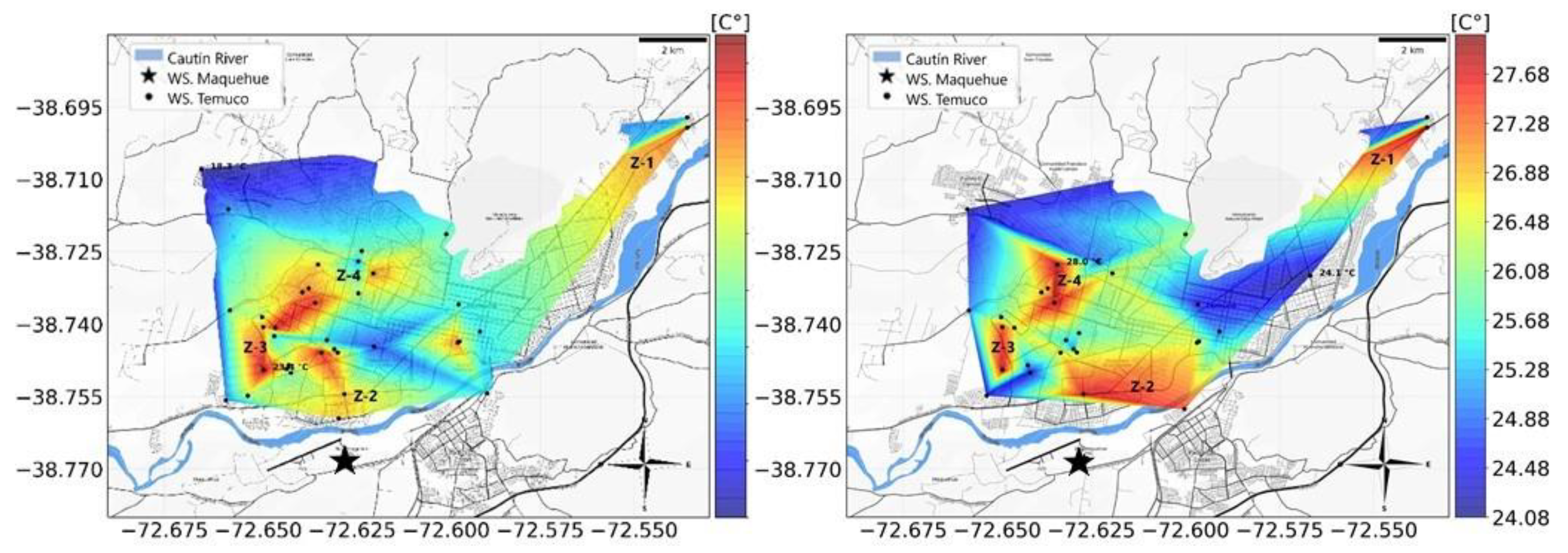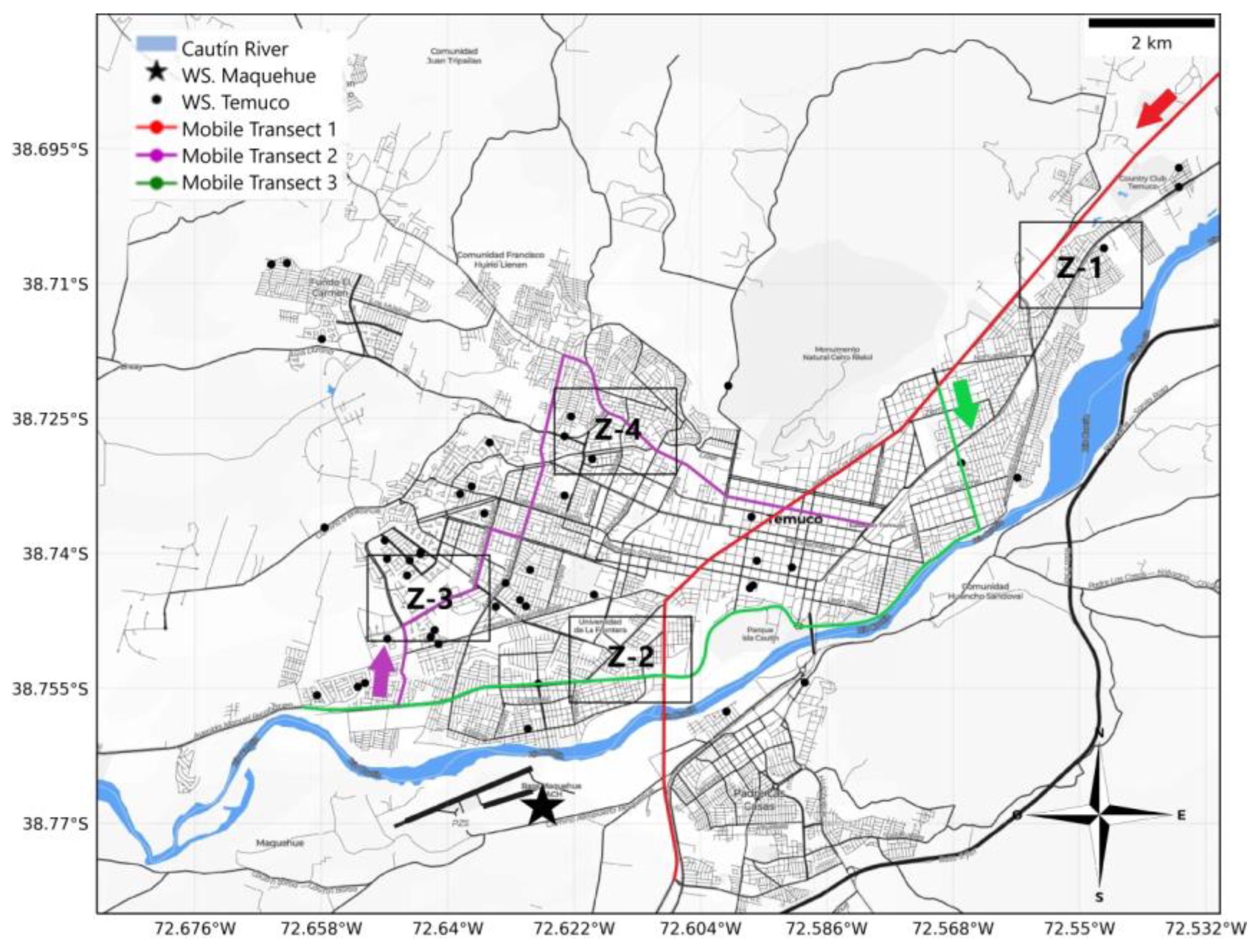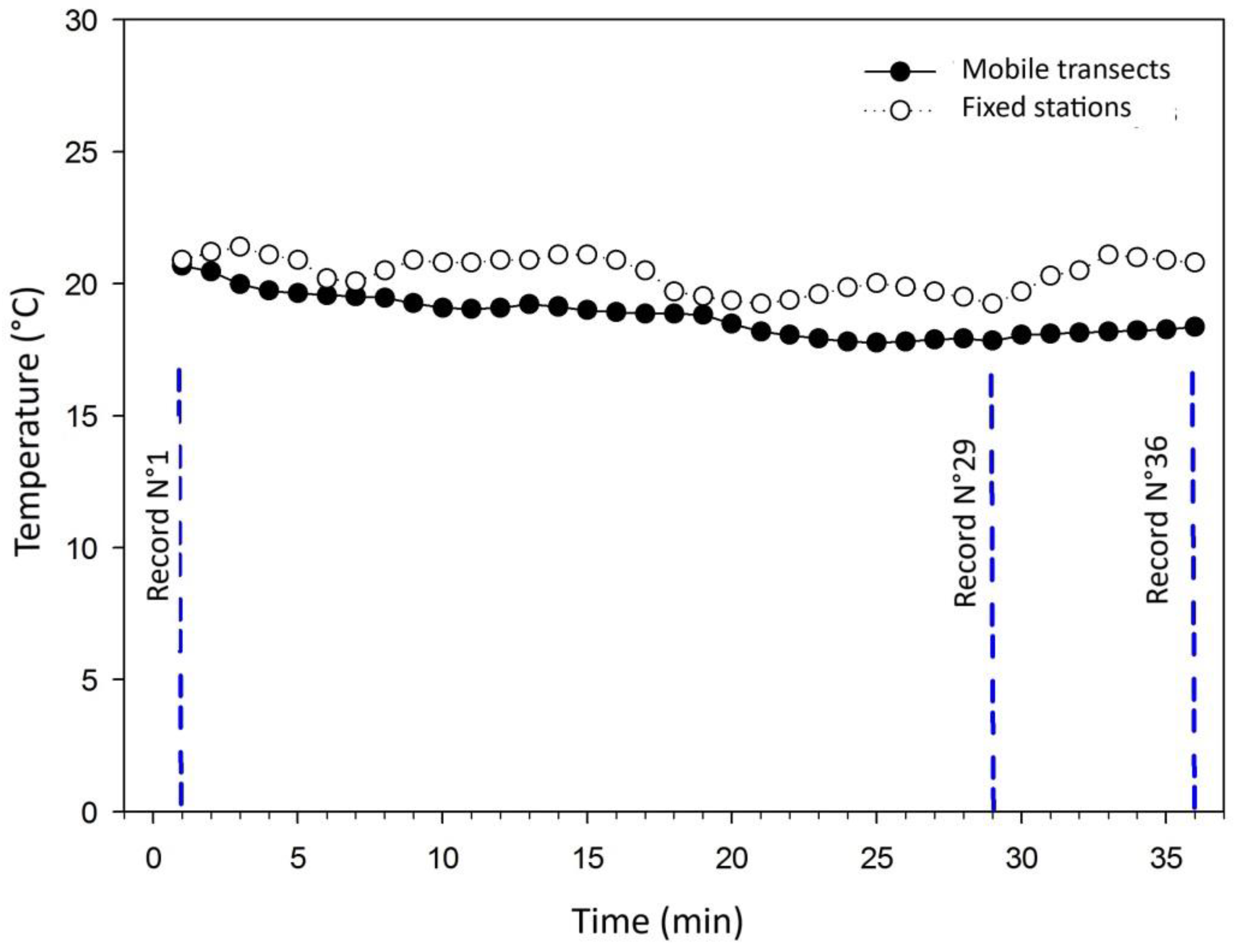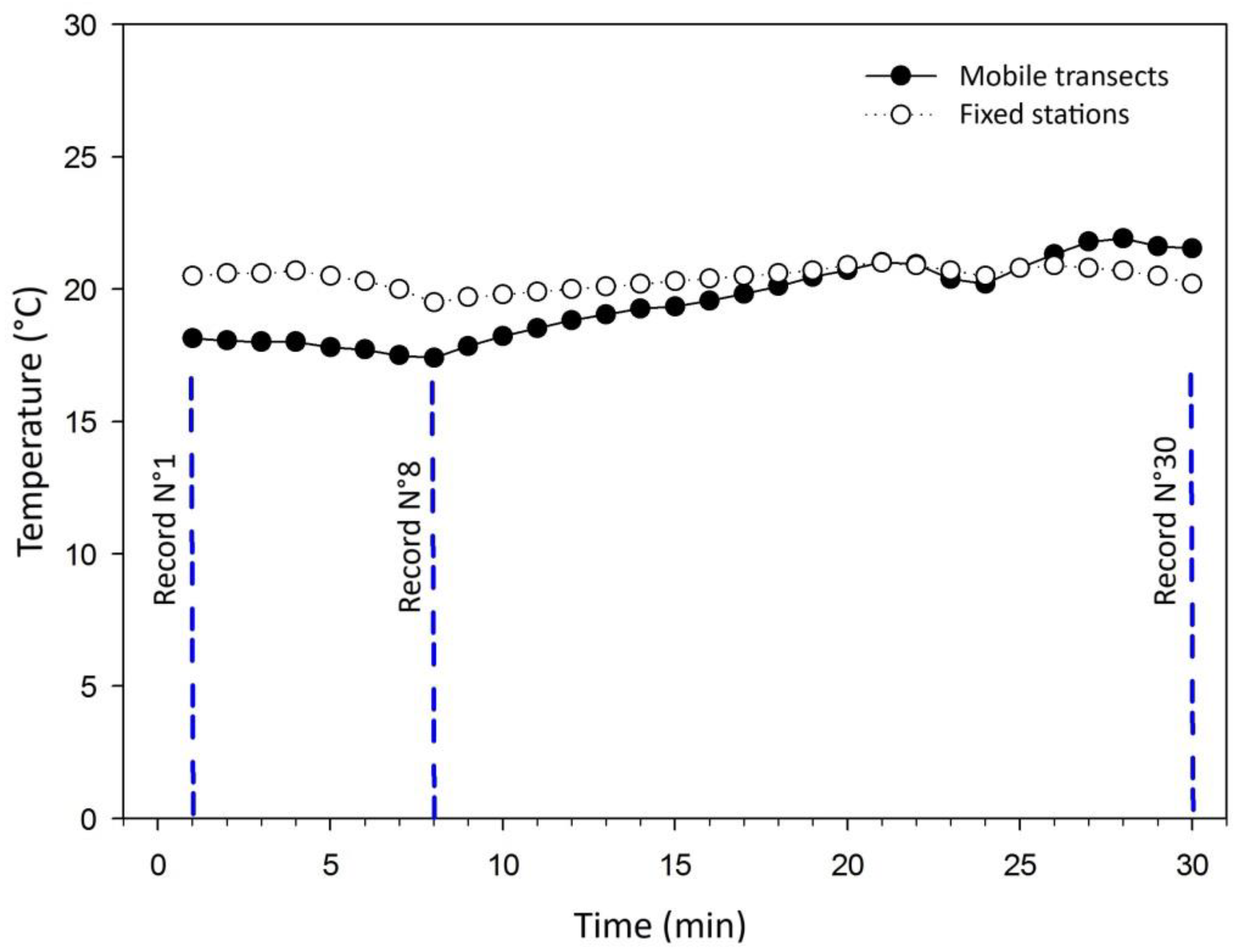Heat on the Move: Contrasting Mobile and Fixed Insights into Temuco’s Urban Heat Islands
Abstract
:1. Introduction
2. Methodology
2.1. Study Area: Temuco
2.2. Procedure to Contrast Heat Island Location Methodologies
2.2.1. Mobile Transect Method
2.2.2. Fixed Station Method
2.3. Methodologies for UHI Simulation and Location in Temuco
- : Maximum urban temperature recorded within the city.
- : Minimum temperature recorded in the surrounding rural areas, serving as a reference for non-urban conditions
3. Results
3.1. Temperature Patterns and Spatial Variability Across Transects
3.2. Location of Heat Islands in Temuco
4. Discussion
5. Conclusions
Author Contributions
Funding
Institutional Review Board Statement
Informed Consent Statement
Data Availability Statement
Acknowledgments
Conflicts of Interest
References
- de Steffens, A.C.; Piccolo, M.C.; Gonzalez, J.H.; Navarrete, G.; Lara, R.M.R. La Isla de Calor en Temuco, Chile: Situacion invernal. Rev. Geofis. 1997, 46, 49–60. [Google Scholar]
- Oke, T.R. City size and the urban heat island. Atmos. Environ. 1967, 7, 1973. [Google Scholar] [CrossRef]
- Stevovic, S.; Mirjanic, D.; Djuric, N. Theory and smart practice in the reduction of negative effects of urban heat Island. Therm. Sci. 2018, 22, 1011–1031. [Google Scholar] [CrossRef]
- García-Cueto, O.R.; Jáuregui-Ostos, E.; Toudert, D.; Tejeda-Martinez, A. Detection of the urban heat island in Mexicali, B.C., México and its relationship with land use. Atmosfera 2007, 20, 113–131. [Google Scholar]
- Pérez, C.A.F. Islas de calor urbano en Tampico, México. Impacto del microclima a la calidad del hábitat. Nova Sci. 2014, 7, 495–515. [Google Scholar] [CrossRef]
- Contreras, A.; Salas, J.A.; Velásquez, G.; Quevedo, H. Determinación De La Isla De Calor Urbano En Ciudad Juarez Mediante Programa De Cómputo. Culcyt. Clima Urbano 2008, 26, 3–16. [Google Scholar]
- Jones, P.D.; Lister, D.H.; Li, Q. Urbanization effects in large-scale temperature records, with an emphasis on China. J. Geophys. Res. Atmos. 2008, 113. [Google Scholar] [CrossRef]
- Fan, Y.; Li, Y.; Bejan, A.; Wang, Y.; Yang, X. Horizontal extent of the urban heat dome flow. Sci Rep 2017, 7, 11681. [Google Scholar] [CrossRef]
- IPCC. Cambio Climático 2014: Informe de síntesis. Contribución de los Grupos I, II y III al Quinto Informe de Evaluación del Grupo de Expertos sobre el Cambio Climático. Quinto Inf. Evaluación 2014, 4, 1–157. [Google Scholar]
- IPCC. Cambio Climático 2007: Informe de Síntesis. Informe del Grupo INTERGUBERNAMENTAL de Expertos Sobre el Cambio Climático; IPCC: Geneva, Switzerland, 2007. [Google Scholar]
- Angel, L.; Ramirez, A.; Dominguez, E. Isla De Calor Y Cambios Espacio-Temporales De La Temperatura En La Ciudad De Bogotá. Rev. Acad. Colomb. Cienc. 2010, 34, 173–183. [Google Scholar]
- Alomar Garau, G.; Llop Garau, J. La isla de calor urbana de Palma (Mallorca, Islas Baleares): Avance para el estudio del clima urbano en una ciudad litoral mediterránea. Boletín Asoc. Geógrafos Españoles 2018, 78, 392–418. [Google Scholar] [CrossRef]
- Kuznetsova, I.N.; Brusova, N.E.; Nakhaev, M.I. Moscow Urban Heat Island: Detection, boundaries, and variability. Russ. Meteorol. Hydrol. 2017, 42, 305–313. [Google Scholar] [CrossRef]
- Jauregui, E. Heat island development in Mexico City. Atmos Env. 1997, 31, 3821–3831. [Google Scholar] [CrossRef]
- Hawkins, T.W.; Brazel, A.J.; Stefanov, W.L.; Bigler, W.; Saffell, E.M. The role of rural variability in urban heat island determination for Phoenix, Arizona. J. Appl. Meteorol. 2004, 43, 476–486. [Google Scholar] [CrossRef]
- Stewart, I.D. A systematic review and scientific critique of methodology in modern urban heat island literature. Int. J. Clim. 2011, 31, 200–217. [Google Scholar] [CrossRef]
- Martínez Martínez, J. Estudio de la isla de calor de la ciudad de Alicante. Investig. Geográficas 2014, 62, 83–89. [Google Scholar] [CrossRef]
- Erell, E.; Williamson, T. Intra-urban differences in canopy layer air temperature at a mid-latitude city. Int. J. Climatol. 2007, 27, 1243–1255. [Google Scholar] [CrossRef]
- Konstantinov, P.I.; Grishchenko, M.Y.; Varentsov, M.I. Mapping urban heat islands of arctic cities using combined data on field measurements and satellite images based on the example of the city of Apatity (Murmansk Oblast). Izv. Atmos. Ocean. Phys. 2015, 51, 992–998. [Google Scholar] [CrossRef]
- Stewart, I.D.; Krayenhoff, E.S.; Voogt, J.A.; Lachapelle, J.A.; Allen, M.A.; Broadbent, A.M. Time Evolution of the Surface Urban Heat Island. Earths Future 2021, 9, e2021EF002178. [Google Scholar] [CrossRef]
- Zhang, Y.; Zhang, J.; Zhang, X.; Zhou, D.; Gu, Z. Analyzing the Characteristics of UHI (Urban Heat Island) in Summer Daytime Based on Observations on 50 Sites in 11 LCZ (Local Climate Zone) Types in Xi’an, China. Sustainability 2020, 13, 83. [Google Scholar] [CrossRef]
- Marquès, E.; Masson, V.; Naveau, P.; Mestre, O.; Dubreuil, V.; Richard, Y. Urban Heat Island Estimation from Crowdsensing Thermometers Embedded in Personal Cars. Bull. Am. Meteorol. Soc. 2022, 103, E1098–E1113. [Google Scholar] [CrossRef]
- Brandsma, T.; Wolters, D. Measurement and Statistical Modeling of the Urban Heat Island of the City of Utrecht (the Netherlands). J. Appl. Meteorol. Climatol. 2012, 51, 1046–1060. [Google Scholar] [CrossRef]
- Sarricolea, P.; Aliste, E.; Castro, P.; Escobedo, C. Análisis de la máxima intensidad de la isla de calor urbana nocturna de la ciudad de Rancagua (Chile) y sus factores explicativos. Rev. Climatol. 2008, 8, 71–84. [Google Scholar]
- Sarricolea Espinoza, P.; Martín-Vide, J. El estudio de la Isla de Calor Urbana de Superficie del Área Metropolitana de Santiago de Chile con imágenes Terra-MODIS y Análisis de Componentes Principales. Rev. Geogr. Norte Gd. 2014, 57, 123–141. [Google Scholar] [CrossRef]
- Burger, M.; Gubler, M.; Heinimann, A.; Brönnimann, S. Modelling the spatial pattern of heatwaves in the city of Bern using a land use regression approach. Urban Clim. 2021, 38, 100885. [Google Scholar] [CrossRef]
- Dian, C.; Pongrácz, R.; Incze, D.; Bartholy, J.; Talamon, A. Analysis of the urban heat island intensity based on air temperature measurements in a renovated part of Budapest (Hungary). Geogr. Pannonica 2019, 23, 277–288. [Google Scholar] [CrossRef]
- Servicio Salud Araucanía Sur. Boletín Demográfico Perfil Socio Demográfico y Sanitario Comuna de Temuco; Servicio Salud Araucanía Sur: Temuco, Chile, 2020; Available online: https://drive.google.com/file/d/1_a5gbLscPUzsmRTv9lllbm7PMJrqzzuQ/view (accessed on 5 December 2024).
- Instituto Nacional de Estadística. Resultados CENSO 2002; Instituto Nacional de Estadística: Santiago, Chile, 2002. [Google Scholar]
- Instituto Nacional Estadística. Resultados CENSO 2017; Instituto Nacional de Estadística: Santiago, Chile, 2017. [Google Scholar]
- Fuentes Pérez, C.A. Climatología urbana por modificación antropogénica. Alteración del balance de energía natural. Dr. Univ. Autónoma Tamaulipas 2015, 9, 73–91. [Google Scholar]
- Moreno, R.; Zamora, R.; Moreno-García, N.; Galán, C. Effects of composition and structure variables of urban trees in the reduction of heat islands; case study, Temuco city, Chile. Build. Env. 2023, 245, 110859. [Google Scholar] [CrossRef]
- Biblioteca Nacional del Congreso de Chile. Clima y Vegetación Región de la Araucanía. Available online: https://www.bcn.cl/siit/nuestropais/region9/clima.htm (accessed on 5 December 2024).
- Montaner-Fernández, D.; Morales-Salinas, L.; Rodriguez, J.S.; Cárdenas-Jirón, L.; Huete, A.; Fuentes-Jaque, G.; Pérez-Martínez, W.; Cabezas, J. Spatio-Temporal Variation of the Urban Heat Island in Santiago, Chile during Summers 2005–2017. Remote Sens. 2020, 12, 3345. [Google Scholar] [CrossRef]
- Sarricolea, P.; Herrera-Ossandon, M.; Meseguer-Ruiz, Ó. Climatic regionalisation of continental Chile. J. Maps 2017, 13, 66–73. [Google Scholar] [CrossRef]
- Godoy, G. Modelo de la Isla de Calor Atmosférico Superficial: Factores en Común y alteraciones para la mitigación de su Efecto en la salud humana y medio ambiente urbano. Univ. Concepc. 2014, 25, 1–21. [Google Scholar] [CrossRef]
- García, M.D.; Pardo, J.A. El estudio de la isla de calor urbana en el ámbito mediterráneo: Una revisión bibliográfica. Biblio3W Rev. Bibliográfica Geogr. Cienc. Soc. 2016, 21, 1179. [Google Scholar]
- Verichev, K.; Salazar-Concha, C.; Díaz-López, C.; Carpio, M. The influence of the urban heat island effect on the energy performance of residential buildings in a city with an oceanic climate during the summer period: Case of Valdivia, Chile. Sustain. Cities Soc. 2023, 97, 104766. [Google Scholar] [CrossRef]
- Zühlke, J.P. Die Verbreitung von Wissen zu Controlling-Instrumenten; Springer Fachmedien: Wiesbaden, Germany, 2007. [Google Scholar] [CrossRef]
- Serra Pardo, J.A. Estudio de la isla de calor de la ciudad de Ibiza. Investig. Geográficas 2007, 44, 55–73. [Google Scholar] [CrossRef]
- Amatriain, X.; Pujol, J.M. Data mining methods for recommender systems. In Recommender Systems Handbook, 2nd ed.; Springer: Boston, MA, USA, 2015. [Google Scholar] [CrossRef]
- Van Kreveld, M. Algorithms for triangulated terrains. In Lecture Notes in Computer Science; (Including subseries Lecture Notes in Artificial Intelligence and Lecture Notes in Bioinformatics); Springer: Berlin/Heidelberg, Germany, 1997. [Google Scholar] [CrossRef]
- Fernández García, F. Manual de Climatología Aplicada: Clima, Medio Ambiente y Planificación, 2nd ed.; Síntesis: Madrid, Spain, 1996. [Google Scholar]
- Liu, L.; Lin, Y.; Liu, J.; Wang, L.; Wang, D.; Shui, T.; Chen, X.; Wu, Q. Analysis of local-scale urban heat island characteristics using an integrated method of mobile measurement and GIS-based spatial interpolation. Build. Environ. 2017, 117, 191–207. [Google Scholar] [CrossRef]
- Cecilia, A.; Casasanta, G.; Petenko, I.; Conidi, A.; Argentini, S. Measuring the urban heat island of Rome through a dense weather station network and remote sensing imperviousness data. Urban Clim. 2023, 47, 101355. [Google Scholar] [CrossRef]
- Kousis, I.; Pigliautile, I.; Pisello, A.L. Intra-urban microclimate investigation in urban heat island through a novel mobile monitoring system. Sci. Rep. 2021, 11, 9732. [Google Scholar] [CrossRef]
- Siu, L.W.; Hart, M.A. Quantifying urban heat island intensity in Hong Kong SAR, China. Environ. Monit Assess. 2013, 185, 4383–4398. [Google Scholar] [CrossRef]
- Heusinkveld, B.G.; Steeneveld, G.J.; Van Hove, L.W.A.; Jacobs, C.M.J.; Holtslag, A.A.M. Spatial variability of the rotterdam urban heat island as influenced by urban land use. J. Geophys. Res. 2014, 119, 677–692. [Google Scholar] [CrossRef]
- Da Silva, V.J.; Da Silva, C.R.; Almeida, L.D.; Da Silva, C.R.; Carvalho, H.D.P.; De Camargo, R. Mobile transect for identification of intra-urban heat islands in Uberlandia, Brazil. Rev. Ambiente Agua 2018, 13, e2187. [Google Scholar] [CrossRef]
- Liu, L.; Liu, J.; Lin, Y. Spatial-temporal Analysis of the Urban Heat Island of a Subtropical City by Using Mobile Measurement. Procedia Eng. 2016, 169, 55–63. [Google Scholar] [CrossRef]
- Dihkan, M.; Karsli, F.; Guneroglu, N.; Guneroglu, A. Evaluation of urban heat island effect in Turkey. Arab. J. Geosci. 2018, 11, 186. [Google Scholar] [CrossRef]
- Sun, C.-Y.; Kato, S.; Gou, Z. Application of Low-Cost Sensors for Urban Heat Island Assessment: A Case Study in Taiwan. Sustainability 2019, 11, 2759. [Google Scholar] [CrossRef]
- Silva, Y.M.N.; Silva, H.M.; De Andrade Silva, R.D.; Marques, E.D.; De Oliveira Gomes, O.V. Identification of the urban heat islands phenomenon in a small city: The study case of Três Rios/RJ, Brazil. Rev. Bras. Ciências Ambient. 2021, 57, 93–104. [Google Scholar] [CrossRef]
- Zeynali, R.; Bitelli, G.; Mandanici, E. Mobile Data Acquisition and Processing In Support Of An Urban Heat Island Study. Int. Arch. Photogramm. Remote Sens. Spat. Inf. Sci. 2023, 48, 563–569. [Google Scholar] [CrossRef]
- Romero Rodríguez, L.; Sánchez Ramos, J.; Sánchez de la Flor, F.J.; Álvarez Domínguez, S. Analyzing the urban heat Island: Comprehensive methodology for data gathering and optimal design of mobile transects. Sustain. Cities Soc. 2020, 55, 102027. [Google Scholar] [CrossRef]
- Kousis, I.; Manni, M.; Pisello, A.L. Environmental mobile monitoring of urban microclimates: A review. Renew. Sustain. Energy Rev. 2022, 169, 112847. [Google Scholar] [CrossRef]
- Lindberg, F.; Olofson, K.F.G.; Sun, T.; Grimmond, C.S.B.; Feigenwinter, C. Urban storage heat flux variability explored using satellite, meteorological and geodata. Theor. Appl. Clim. 2020, 141, 271–284. [Google Scholar] [CrossRef]
- Li, D.; Yan, S.; Chen, G. Effects of Urban Redevelopment on Surface Urban Heat Island. IEEE J. Sel. Top. Appl. Earth Obs. Remote Sens. 2023, 16, 2366–2373. [Google Scholar] [CrossRef]
- Li, H.; Zhou, Y.; Jia, G.; Zhao, K.; Dong, J. Quantifying the response of surface urban heat island to urbanization using the annual temperature cycle model. Geosci. Front. 2022, 13, 101141. [Google Scholar] [CrossRef]
- Wang, J.; Zhou, W.; Wang, J. Time-series analysis reveals intensified urban heat island effects but without significant urban warming. Remote Sens. 2019, 11, 2229. [Google Scholar] [CrossRef]
- Earl, N.; Simmonds, I.; Tapper, N. Weekly cycles in peak time temperatures and urban heat island intensity. Environ. Res. Lett. 2016, 11, 074003. [Google Scholar] [CrossRef]
- Gaffin, S.R.; Rosenzweig, C.; Khanbilvardi, R.; Parshall, L.; Mahani, S.; Glickman, H.; Goldberg, R.; Blake, R.; Slosberg, R.B.; Hillel, D. Variations in New York city’s urban heat island strength over time and space. Theor. Appl. Clim. 2008, 94, 1–2. [Google Scholar] [CrossRef]
- Schrijvers, P.J.C.; Jonker, H.J.J.; Kenjereš, S.; de Roode, S.R. Breakdown of the night time urban heat island energy budget. Build. Environ. 2015, 83, 50–64. [Google Scholar] [CrossRef]
- Chen, T.; Sun, A.; Niu, R. Effect of land cover fractions on changes in surface urban heat islands using landsat time-series images. Int. J. Environ. Res. Public Health 2019, 16, 971. [Google Scholar] [CrossRef]
- Mathew, A.; Khandelwal, S.; Kaul, N. Analysis of diurnal surface temperature variations for the assessment of surface urban heat island effect over Indian cities. Energy Build. 2018, 159, 271–295. [Google Scholar] [CrossRef]
- Estrada, F.; Perron, P. Disentangling the trend in the warming of urban areas into global and local factors. Ann. N. Y. Acad. Sci. 2021, 1504, 230–246. [Google Scholar] [CrossRef]
- Chow, W.T.L.; Salamanca, F.; Georgescu, M.; Mahalov, A.; Milne, J.M.; Ruddell, B.L. A multi-method and multi-scale approach for estimating city-wide anthropogenic heat fluxes. Atmos. Environ. 2014, 99, 64–76. [Google Scholar] [CrossRef]
- Ghaddar, Z.; Ghali, K.; Ghaddar, N. The impact of the air-conditioning systems on the urban microclimate of beirut city. Renew. Energy Power Qual. J. 2017, 1, 882–885. [Google Scholar] [CrossRef]
- Lipson, M.J.; Thatcher, M.; Hart, M.A.; Pitman, A. A building energy demand and urban land surface model. Q. J. R. Meteorol. Soc. 2018, 144, 1572–1590. [Google Scholar] [CrossRef]
- Lein, J.K.; Hong, X. Fingerprinting Anthropogenic ‘Waste’ Heat Across an Urban Landscape Using Earth Observational Satellite Data. J. Environ. Sci. Allied Res. 2017, 2017, 1–10. [Google Scholar] [CrossRef]
- Yao, R.; Luo, Q.; Luo, Z.; Jiang, L.; Yang, Y. An integrated study of urban microclimates in Chongqing, China: Historical weather data, transverse measurement and numerical simulation. Sustain. Cities Soc. 2015, 14, 187–199. [Google Scholar] [CrossRef]
- Mandelmilch, M.; Ferenz, M.; Mandelmilch, N.; Potchter, O. Urban spatial patterns and heat exposure in the Mediterranean City of Tel Aviv. Atmosphere 2020, 11, 963. [Google Scholar] [CrossRef]
- Husni, E.; Prayoga, G.A.; Tamba, J.D.; Retnowati, Y.; Fauzandi, F.I.; Yusuf, R.; Yahya, B.N. Microclimate investigation of vehicular traffic on the urban heat island through IoT-Based device. Heliyon 2022, 8, e11739. [Google Scholar] [CrossRef]
- Zou, Z.; Yan, C.; Yu, L.; Jiang, X.; Ding, J.; Qin, L.; Wang, B.; Qiu, G. Impacts of land use/land cover types on interactions between urban heat island effects and heat waves. Build. Environ. 2021, 204, 108138. [Google Scholar] [CrossRef]
- Kousis, I.; Pigliautile, I.; Pisello, A.L. A Mobile Vehicle-Based Methodology for Dynamic Microclimate Analysis. Int. J. Environ. Res. 2021, 15, 893–901. [Google Scholar] [CrossRef]
- Lamer KLuke, E.P.; Walsh Jr, B.; Andrade, S.; Mages, Z.; Zhu, Z.; Leghart, E.; Treserras, B.P.; Emrick, A.; Kollias, P. Going Mobile to Address Emerging Climate Equity Needs in the Heterogeneous Urban Environment. Bull. Am. Meteorol. Soc. 2022, 103, E2069–E2080. [Google Scholar] [CrossRef]








| Correlation | Pearson’s Correlation Coefficient (r) | Interpretation |
|---|---|---|
| Perfect | r = 1 | Perfect similarity, identical profiles |
| Very strong | 0.75 ≤ r ≤ 1 | Very similar, significant similarity |
| Medium | 0.50 ≤ r ≤ 0.75 | Moderate similarity |
| Weak | 0.00 ≤ r ≤ 0.50 | Little similarity |
| None | 0.00 | No correlation |
| Very weak | −1 ≤ r ≤ 0.00 | Very large differences, opposite curves |
| Date–Time | ID | T [°C] | Latitude | Longitude |
|---|---|---|---|---|
| 2017-01-10 00:00:00 | 245 | 9.0 | −38.721 | −72.600 |
| 2017-01-10 00:00:00 | 246 | 9.4 | −38.707 | −72.665 |
| 2018-12-11 23:30:00 | 294 | 15.2 | −38.740 | −72.648 |
| Classification | Intensity | Interpretation |
|---|---|---|
| Weak | UHI ≤ 2 °C | There is no major difference between the temperature in the city and adjacent sectors |
| Moderate | 2 °C < UHI ≤ 4 °C | There is a slight difference between the temperature in the city and adjacent sectors not perceptible by people |
| Strong | 4 °C < UHI ≤ 6 °C | The difference in temperature between the city and adjacent sectors is moderately perceptible by people |
| Very strong | 6 °C < UHI ≤ 8 °C | There is a big difference in temperature between the city and adjacent sectors very perceptible by people |
| Extremely strong | 8 °C < UHI | The difference in temperature between the city and adjacent sectors is extreme and dangerous for people |
Disclaimer/Publisher’s Note: The statements, opinions and data contained in all publications are solely those of the individual author(s) and contributor(s) and not of MDPI and/or the editor(s). MDPI and/or the editor(s) disclaim responsibility for any injury to people or property resulting from any ideas, methods, instructions or products referred to in the content. |
© 2025 by the authors. Licensee MDPI, Basel, Switzerland. This article is an open access article distributed under the terms and conditions of the Creative Commons Attribution (CC BY) license (https://creativecommons.org/licenses/by/4.0/).
Share and Cite
Martinez-Soto, A.; Vera-Fonseca, M.; Valenzuela-Toledo, P.; Melillan-Raguileo, A.; Shupler, M. Heat on the Move: Contrasting Mobile and Fixed Insights into Temuco’s Urban Heat Islands. Sensors 2025, 25, 1251. https://doi.org/10.3390/s25041251
Martinez-Soto A, Vera-Fonseca M, Valenzuela-Toledo P, Melillan-Raguileo A, Shupler M. Heat on the Move: Contrasting Mobile and Fixed Insights into Temuco’s Urban Heat Islands. Sensors. 2025; 25(4):1251. https://doi.org/10.3390/s25041251
Chicago/Turabian StyleMartinez-Soto, Aner, Michelle Vera-Fonseca, Pablo Valenzuela-Toledo, Aliwen Melillan-Raguileo, and Matthew Shupler. 2025. "Heat on the Move: Contrasting Mobile and Fixed Insights into Temuco’s Urban Heat Islands" Sensors 25, no. 4: 1251. https://doi.org/10.3390/s25041251
APA StyleMartinez-Soto, A., Vera-Fonseca, M., Valenzuela-Toledo, P., Melillan-Raguileo, A., & Shupler, M. (2025). Heat on the Move: Contrasting Mobile and Fixed Insights into Temuco’s Urban Heat Islands. Sensors, 25(4), 1251. https://doi.org/10.3390/s25041251







